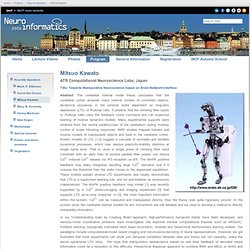

Mitsuo Kawato — Neuroinformatics 2008. Title: Towards Manipulative Neuroscience based on Brain-Network-Interface Abstract: The cerebellar internal model theory postulates that the cerebellar cortex acquires many internal models of controlled objects, dynamical processes in the external world dependent on long-term depression (LTD) of Purkinje cells.

It predicts that the climbing fiber inputs to Purkinje cells carry the feedback motor command and can supervise learning of inverse dynamics models. Many experimental supports were obtained from the ventral paraflocculus of the cerebellum during monkey control of ocular following responses. fMRI studies mapped forward and inverse models of manipulated objects and tools in the cerebellar cortex.
Kinetic models of LTD [1,2] suggest a cascade of excitable and bistable dynamical processes, which may resolve plasticity-stability dilemma at single spine level. Instant Complex Skills Training, Like in The Matrix? Scientists in Boston and Tokyo are developing an advanced form of fMRI neurofeedback that promises to make the learning of complex skills both faster and easier.

The study was published in the Journal Science. When we learn complex skills consciously, we typically practise the skill over and over, comparing our performance with an ideal performance. Eventually, our skills generally improve, and become automatic -- bypassing the conscious level. What Is Neurofeedback ? - EEG INFO Videos. Neurofeedback. Software real time data of neurofeedback training.

Neurofeedback (NFB), also called neurotherapy or neurobiofeedback, is a type of biofeedback that uses realtime displays of electroencephalography (EEG) or hemoencephalography (HEG) to illustrate brain activity and teach self-regulation. EEG neurofeedback uses sensors that are placed on the scalp to measure brain waves, while HEG neurofeedback uses infrared (IR) sensors or functional magnetic resonance imaging (fMRI) to measure brain blood flow. Definition[edit] Neurofeedback is a type of biofeedback that measures brain waves to produce a signal that can be used as feedback on brain activity to teach self-regulation. Neurofeedback is commonly provided using video or sound, with positive feedback for desired brain activity and negative feedback for brain activity that is undesirable.